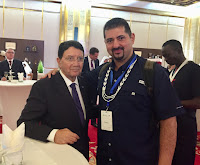Interested in travel posts? See below.
Abu Dhabi (UAE) is HERE.
Budapest, Hungary: at the Crossroads: HERE.
Brunei is HERE.
Calgary, Canada is HERE. I attended the Canada Cup (2019).
Casablanca, Morocco, the NYC of Northern Africa, is HERE. (Rabat is included.)
Cebu, Philippines is HERE. Bonus: Margarito B. Teves and Manila (2018). My favorite cities in the Philippines are Palawan, Dumaguete, and Cebu. (Bonus: interview with a Cebuana HERE, and Manila's Chinatown is HERE.)
Doha, Qatar is HERE.
Edinburgh, Scotland is HERE. (2019)
Havana, Cuba (Part 1) is HERE.
India, the "Golden Triangle" of Jaipur, New Delhi, and Agra, has a multi-part series. Part 1 starts HERE. Post-trip summary is HERE.
Istanbul, Turkey is HERE.
Izmir/Ephesus/Kusadasi/Sirince, Turkey is HERE.
Jakarta, Indonesia is HERE (Asian Games of 2018).
Kazakhstan is HERE (2019).
Konya, Turkey, where Rumi and Shams are buried, is HERE.
Lisbon, Portugal is HERE.
London, England and Heathrow are HERE (Cambridge & Oxford also included).
Malatya, Turkey is HERE.
Medan, Indonesia (North Sumatra) is HERE. (Bonus: Jepara, Indonesia is HERE and Madakaripura waterfall is HERE.)
Mexico is referred to generally HERE and HERE. (Bonus: HERE) Queretaro and Morelia are HERE.
Muscat, Oman is HERE.
Padang, Indonesia: City of Waterfalls and Dragonflies is HERE.
Palembang, Indonesia: interview with an Indonesian backpacker and archaeology/history buff is HERE.
Prague, Czech Republic: Original Hipster Nation is HERE.
Quebec, Canada: Avoid at all Costs is HERE. Quebec City's Winter Carnaval is HERE. (2019)
San Pedro de Atacama, Chile is HERE. (Photos only.)
Saigon, Vietnam is HERE. (Bonus: Hanoi is HERE and Hue, Vietnam is HERE.)
Santo Domingo, Dominican Republic is HERE (2018). A great city, but one that is sure to become increasingly "touristy" with time.
Sharjah (UAE) is HERE.
Sverige aka Sweden is HERE (2021).
Tbilisi, Georgia is HERE.
Tirana, Albania: interview with Auron Tare is HERE.
Tunis, Tunisia (and Sidi Bou Said) is HERE.
Toronto, Canada is HERE. (Bonus: Toronto Museum, second-best Islamic Art museum I've seen after Doha's.)
UNWTO's 2017 Conference is HERE.
USA: Iowa ("Once Fertile, Now Barren") is HERE (2018). Orlando, Florida (DisneyWorld) is HERE (2019). Seattle, Washington is HERE (2008).
Vienna, Austria is HERE. I did not like the city.
Yogyakarta, Indonesia and Prambanan are HERE. Are you interested in Buddhism? You've got to visit.
My lengthy post about visiting 18 countries in 5 months is HERE. A shorter one is HERE ("Adventures in Travel").
You may also follow me on IG under matthewrafat or Twitter @matthewrafat to see more photos.
Bonus: What have I learned in my travels? More HERE (2018).
Bonus: What to pack when traveling? More HERE (2018). What to do when returning? More HERE, at end of post (2019).
Bonus: after seeing 50 countries I think I finally understand Western history. To that end, I've created two posts that presume to explain events from 1919 to 2019 in context. You can start HERE, then go HERE.
Abu Dhabi (UAE) is HERE.
Budapest, Hungary: at the Crossroads: HERE.
Brunei is HERE.
Calgary, Canada is HERE. I attended the Canada Cup (2019).
Casablanca, Morocco, the NYC of Northern Africa, is HERE. (Rabat is included.)
Cebu, Philippines is HERE. Bonus: Margarito B. Teves and Manila (2018). My favorite cities in the Philippines are Palawan, Dumaguete, and Cebu. (Bonus: interview with a Cebuana HERE, and Manila's Chinatown is HERE.)
Doha, Qatar is HERE.
Edinburgh, Scotland is HERE. (2019)
Havana, Cuba (Part 1) is HERE.
India, the "Golden Triangle" of Jaipur, New Delhi, and Agra, has a multi-part series. Part 1 starts HERE. Post-trip summary is HERE.
Istanbul, Turkey is HERE.
Izmir/Ephesus/Kusadasi/Sirince, Turkey is HERE.
Jakarta, Indonesia is HERE (Asian Games of 2018).
Kazakhstan is HERE (2019).
Konya, Turkey, where Rumi and Shams are buried, is HERE.
Lisbon, Portugal is HERE.
London, England and Heathrow are HERE (Cambridge & Oxford also included).
Malatya, Turkey is HERE.
Medan, Indonesia (North Sumatra) is HERE. (Bonus: Jepara, Indonesia is HERE and Madakaripura waterfall is HERE.)
Mexico is referred to generally HERE and HERE. (Bonus: HERE) Queretaro and Morelia are HERE.
Muscat, Oman is HERE.
Padang, Indonesia: City of Waterfalls and Dragonflies is HERE.
Palembang, Indonesia: interview with an Indonesian backpacker and archaeology/history buff is HERE.
Prague, Czech Republic: Original Hipster Nation is HERE.
Quebec, Canada: Avoid at all Costs is HERE. Quebec City's Winter Carnaval is HERE. (2019)
San Pedro de Atacama, Chile is HERE. (Photos only.)
Saigon, Vietnam is HERE. (Bonus: Hanoi is HERE and Hue, Vietnam is HERE.)
Santo Domingo, Dominican Republic is HERE (2018). A great city, but one that is sure to become increasingly "touristy" with time.
Sharjah (UAE) is HERE.
Sverige aka Sweden is HERE (2021).
Tbilisi, Georgia is HERE.
Tirana, Albania: interview with Auron Tare is HERE.
Tunis, Tunisia (and Sidi Bou Said) is HERE.
Toronto, Canada is HERE. (Bonus: Toronto Museum, second-best Islamic Art museum I've seen after Doha's.)
UNWTO's 2017 Conference is HERE.
USA: Iowa ("Once Fertile, Now Barren") is HERE (2018). Orlando, Florida (DisneyWorld) is HERE (2019). Seattle, Washington is HERE (2008).
Vienna, Austria is HERE. I did not like the city.
Yogyakarta, Indonesia and Prambanan are HERE. Are you interested in Buddhism? You've got to visit.
My lengthy post about visiting 18 countries in 5 months is HERE. A shorter one is HERE ("Adventures in Travel").
You may also follow me on IG under matthewrafat or Twitter @matthewrafat to see more photos.
Bonus: What have I learned in my travels? More HERE (2018).
Bonus: What to pack when traveling? More HERE (2018). What to do when returning? More HERE, at end of post (2019).
Bonus: after seeing 50 countries I think I finally understand Western history. To that end, I've created two posts that presume to explain events from 1919 to 2019 in context. You can start HERE, then go HERE.
Bonus: as a non-Muslim, will you be safe in Muslim countries? More HERE (2020).







